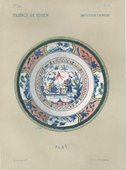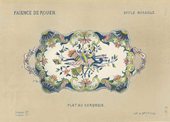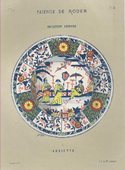Few people can afford to collect the finest porcelain ever made, and most will never have an opportunity to see any. Everyone, however, is able to enjoy beautiful lithographs of fine early porcelain. Some of the most beautiful are the fine antique lithographs from late in the 19th century which record the best examples of French porcelain from the factories of Faience in Rouen. The history of the development of soft porcelain is well-represented in the lovely antique lithographs of Faience porcelain.
From the 14th century on Venetians, Portuguese and Dutch all carried Chinese porcelain to Europe. "Hard" porcelain is made from a paste that is a mixture of water, alumina (white clay) and silica (often seen in grains of quartz or sand. The composition of artificial or "soft" porcelain varied with each production style. Soft porcelain indicates that the porcelain cannot resist as high a temperature as hard porcelain, and also that the soft glaze of the porcelain can be scratched more easily.
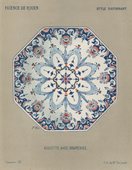
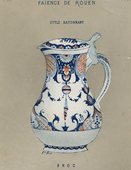
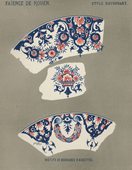
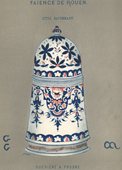
The creation of the first soft porcelain is attributed to Edme Poterat (1612-1687). Over the years blue faience lambrequin embroidery decoration became famous. The earliest Faience decoration was very simple. Also popular, valance decoration (used also in Italy) originated in China. Poterat's soft porcelain Faience with classic valance-style decoration in blue and white developed to even more beautiful soft red, blue and white colours (sometimes with yellow highlights).
Following Edme's death his widow and son Michael took over the original factory, but Michael's brother Louis Poterat (1673-1696) created his own factory nearby. With the soft-coloured warm milky white translucent Faience earthenware the Poterat family invented bone china in France. Traditionally it was decorated by foliated patterns and floral designs of typical French style, or ornamented by coloured designs in imitation of the old Chinese and Japanese porcelain.
